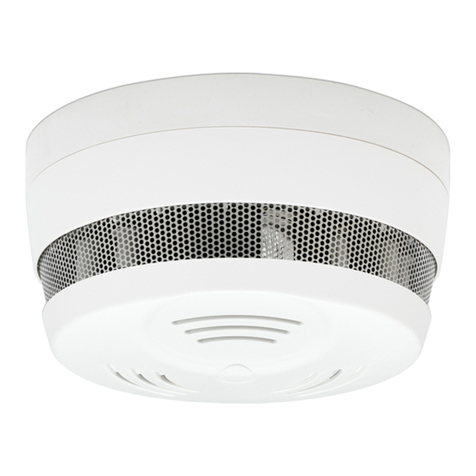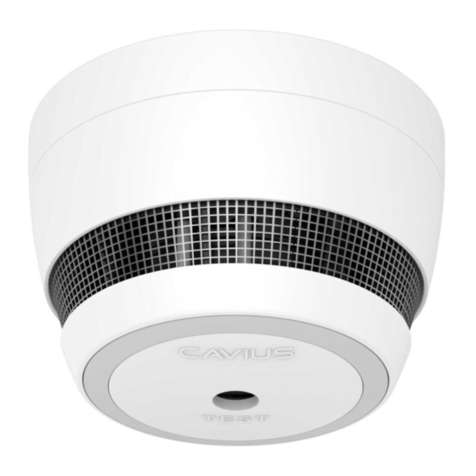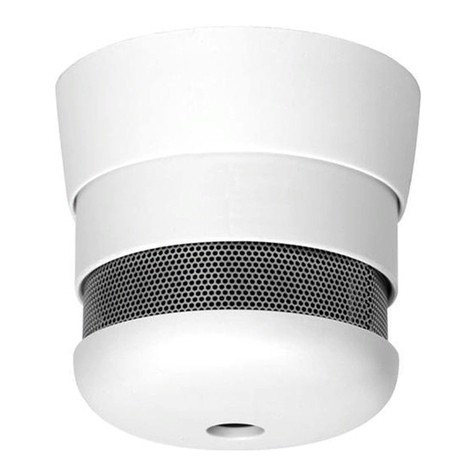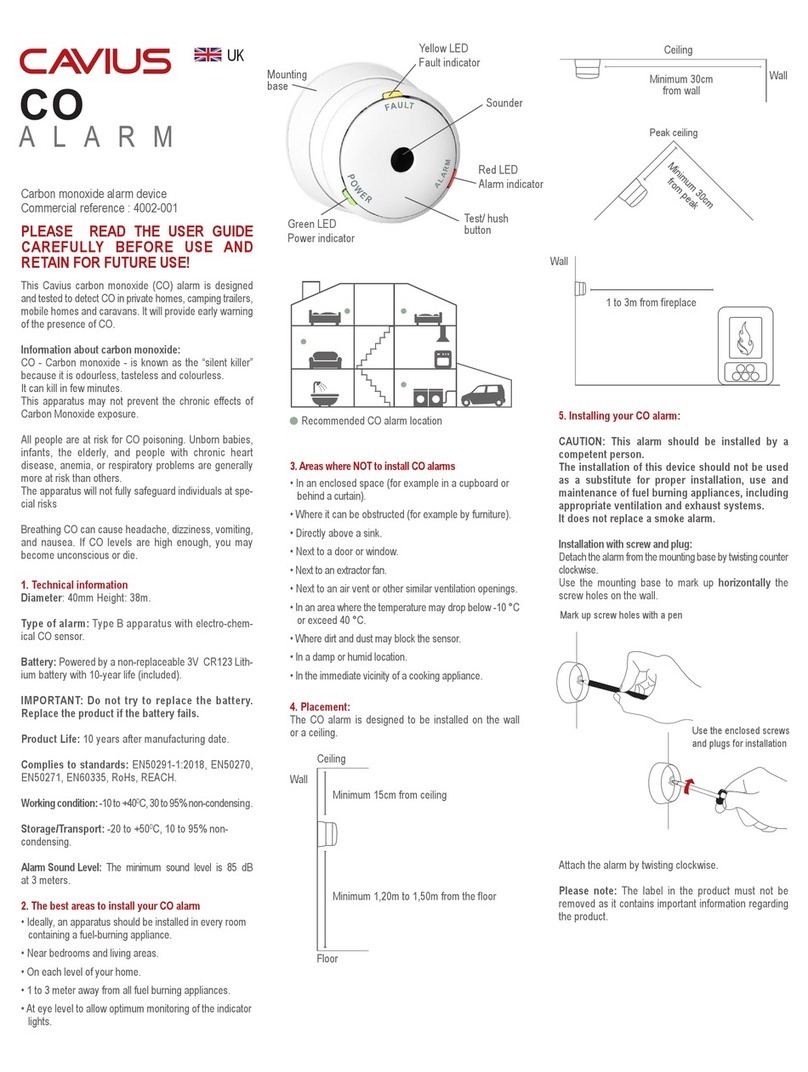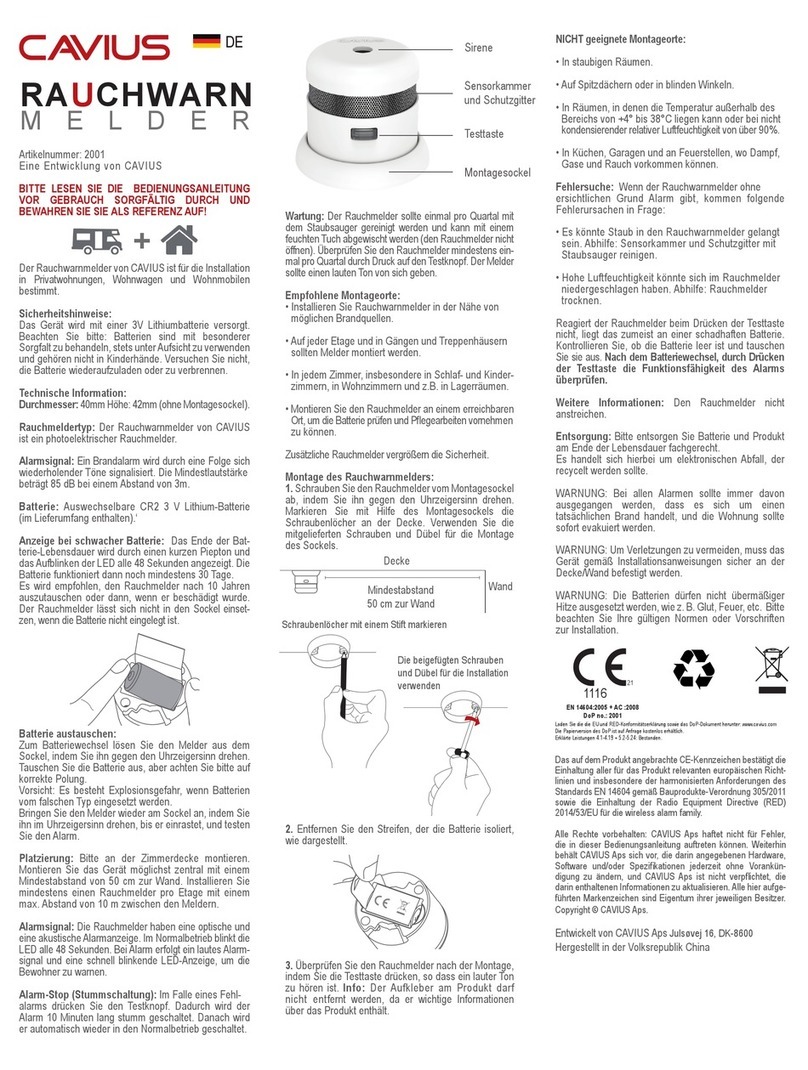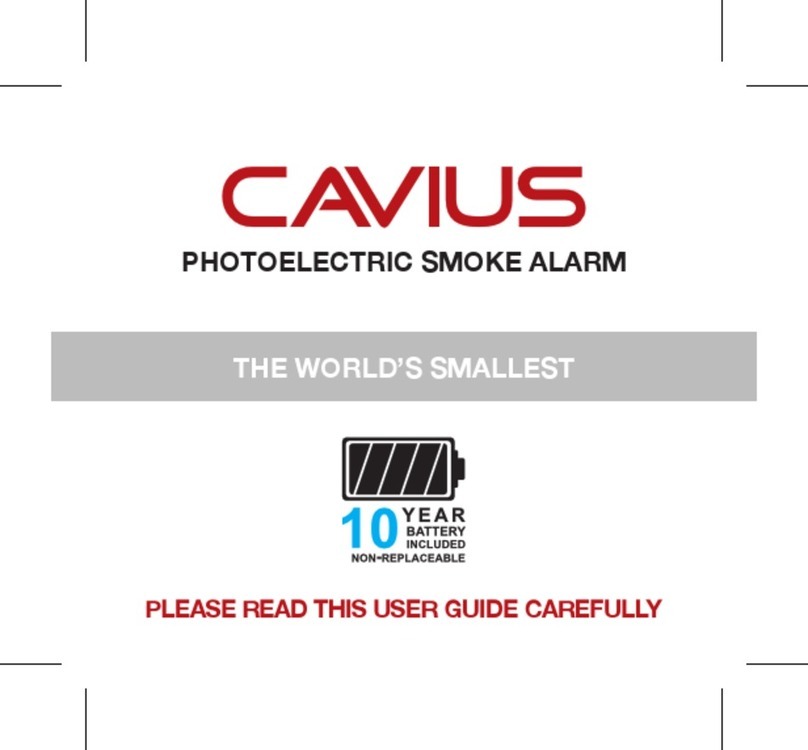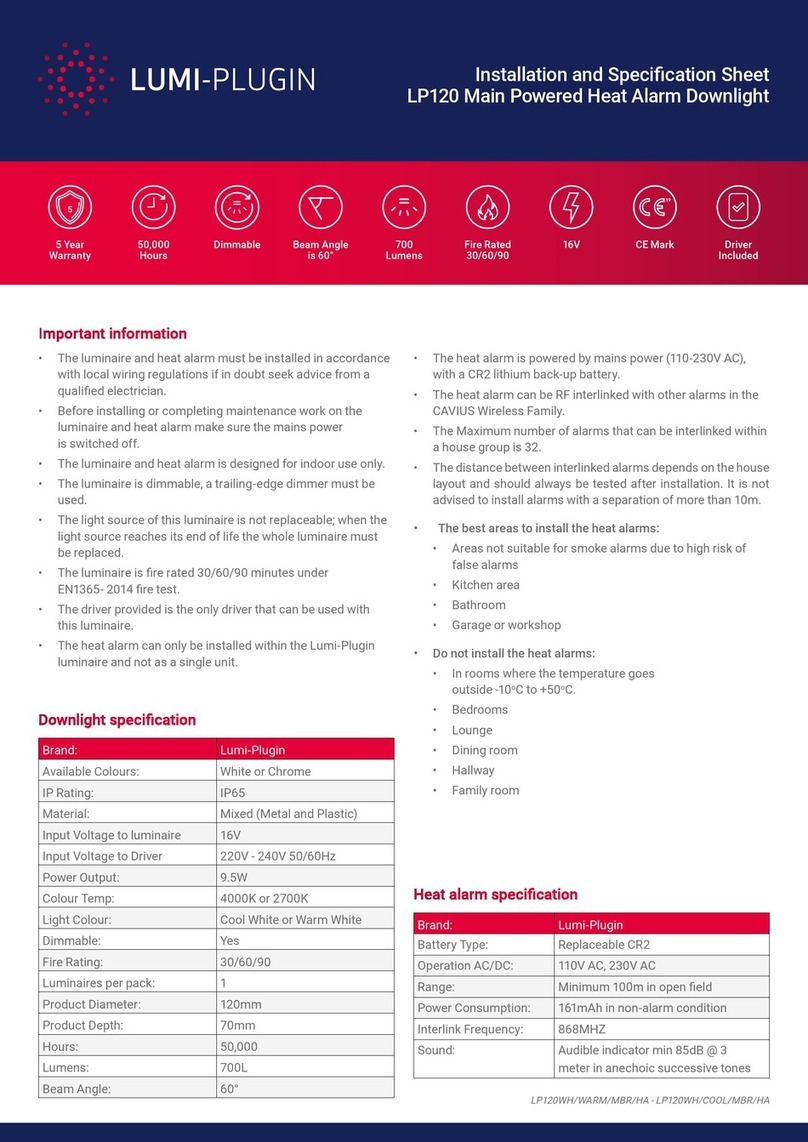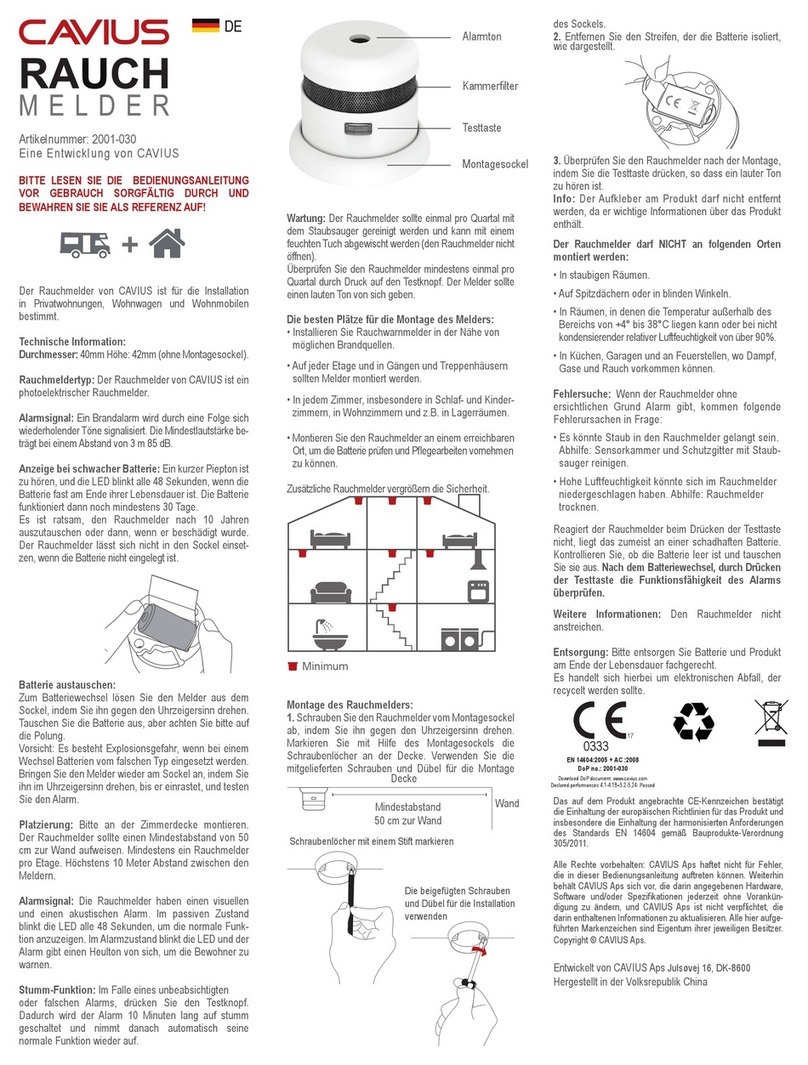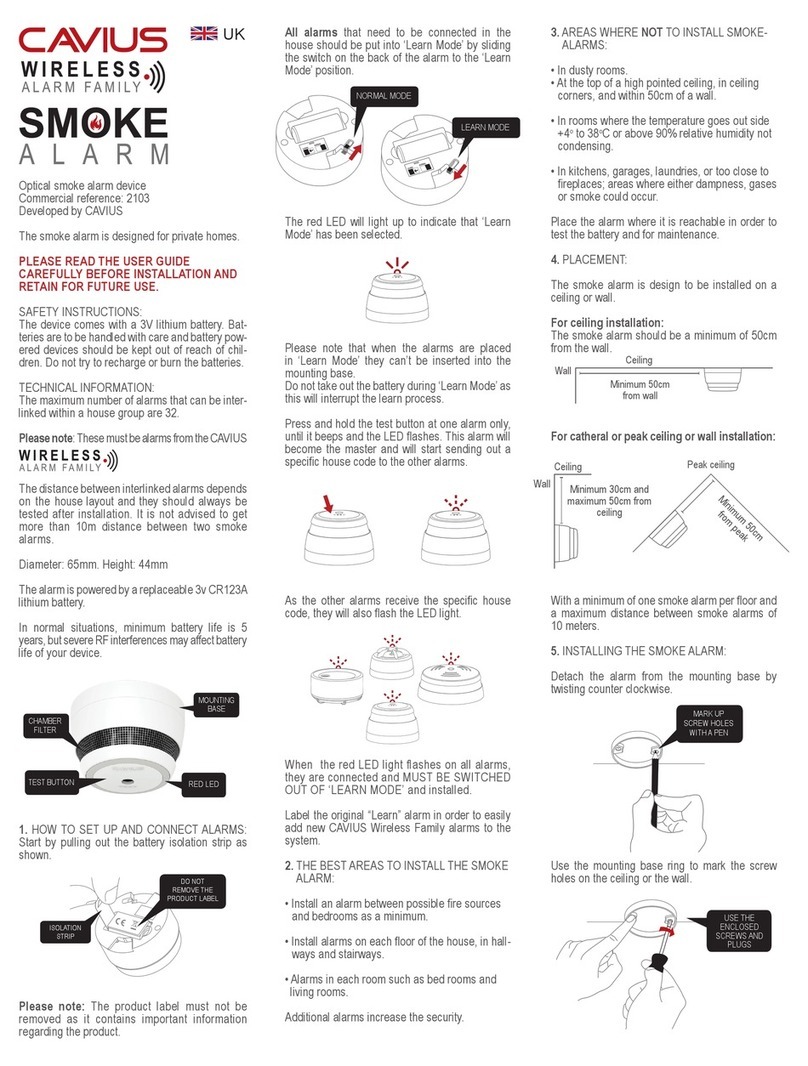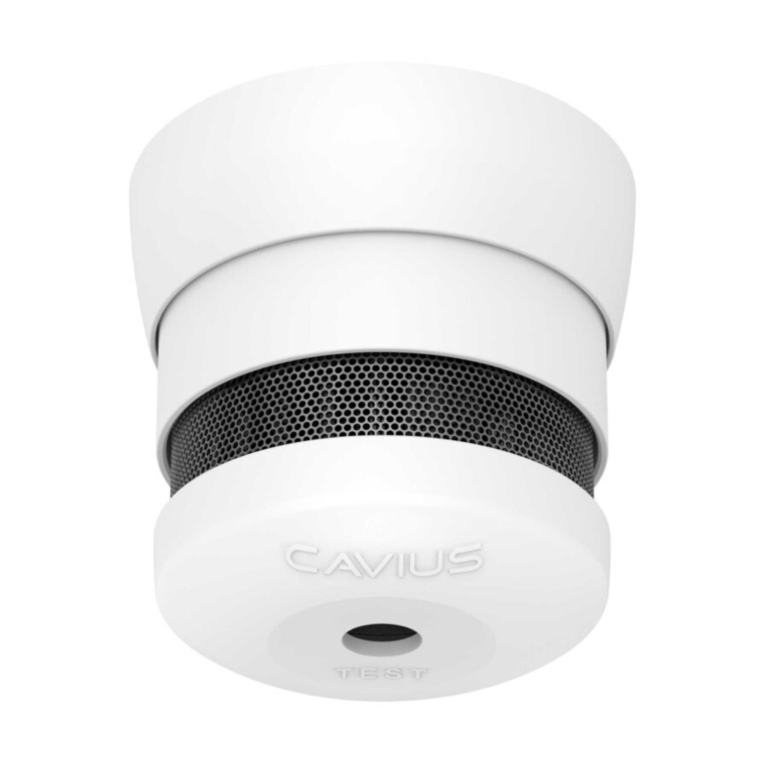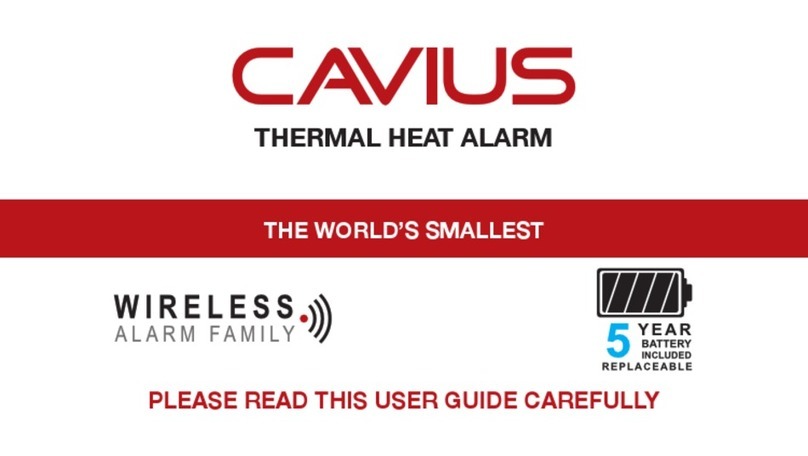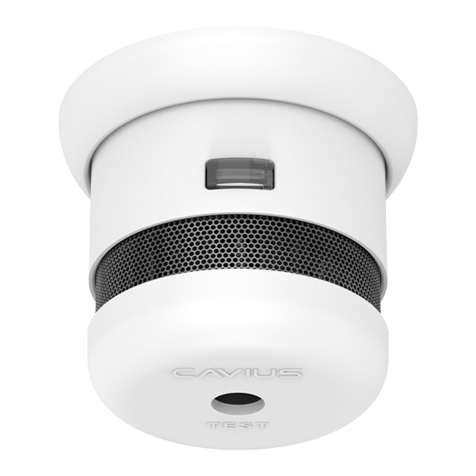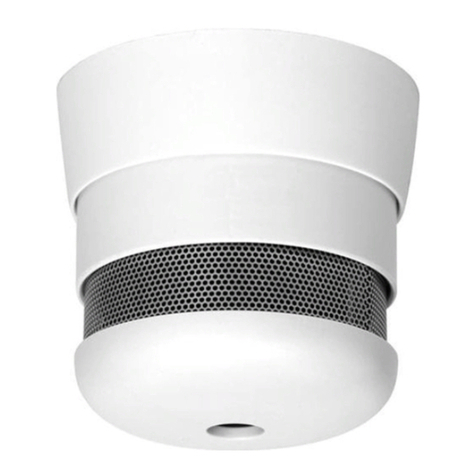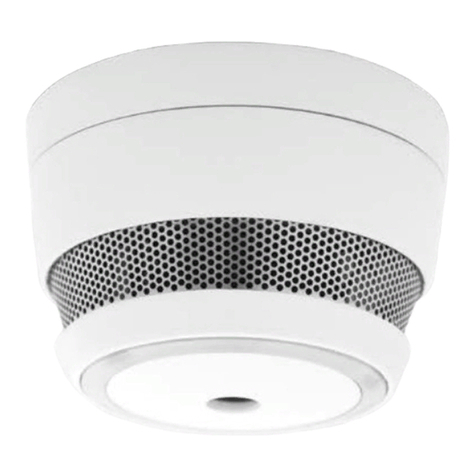
4
6. TEST FUNCTION:
After installation, and at least once per quarter,
test all of your alarms to ensure they are operating
correctly and are within range of each other.
It is recommended to check visually every week if
the LED ashes correctly (every 48sec.).
Press the test button on any alarm for at least 10
seconds.This will send out a test signal from the
alarm; all other connected alarms should receive
the signal within a short time. The alarms will emit a
short beep and the LED will ash every 8 seconds
for 2 minutes.
NOTE: Test function also transmits a weaker RF
signal to ensure an optimal operation in normal
conditions.
When the test signal is sent out, the alarms will
respond in two ways:
1. A single beep every 8 seconds indicates that the
alarms are connected and functioning.
2. Three short beeps every 8 seconds indicates a
smoke sensor fault. The alarm should be cleaned
by running the vacuum (on a low setting) around the
smoke alarm chamber and in the provided vacuum
slot, then tested again.
If required this indication can be stopped early on
each alarm by a short press of the test button.
10. ADD EXTRA DEVICE:
The mains powered smoke alarm can be used
together with alarms in the CAVIUS™ Wireless
Family range. All CAVIUS™ interconnected
alarms within the Wireless Family run on the same
frequency and use the same data protocol.
This means that the wireless system can consist of
a combination of smoke, heat, ood etc.
Place all alarms into ‘Learn Mode’ and repeat
section 1.
Always test connection to all devices by repeating
‘Test Function’ (section 6) after adding devices.
11. LOW BATTERY SIGNAL:
Your product has a battery back-up with a 1 year life
in battery mode without mains power, and up to 10
years normal life with mains.
When the battery is starting its end of life, a short
beep will sound out every 48 seconds for 30 days.
Only the alarm with the low battery will sound,
no other connected alarms will sound. It is safe
to change batteries in the alarms without going
through the learn process again – they will not forget
the codes during the battery change process.
12. SINUSOIDAL POWER SOURCES:
The smoke alarm cannot be used with square wave
or non-sinusoidal power source.
7. NORMAL MODE:
In normal mode the LED will ash every 48 seconds
to show correct operation.
The green LED is on when the alarm is connected
to mains power. It may take up to 1 minute to
indicate that mains power has been connected.
8. ALARM MODE:
When the smoke is detected, the smoke alarm will
go into ‘Alarm Mode’. It will sound the alarm signal
and the red LED will ash.
The smoke alarm will also transmit the alarm signal
to the other connected alarms, which will also
sound the alarm signal after a short delay.
The CAVIUS™ Wireless Family have two dierent
alarm signals:
Alarm signal 1 (--- --- ---) is life threatening alarms,
like a smoke alarm.
9. PAUSE/HUSH FUNCTION:
If the smoke alarms are set into a false alarm by
cooking, replace, etc. they can be hushed for
10 minutes by pressing the test button on the
originating smoke alarm only (indicated by the
ashing LED).
The reason for this is that it is necessary to locate
the source of the alarm before using the hush
function. This is to make sure that it is not a life-
threatening situation.
12. BATTERY REPLACEMENT:
To replace the battery, detach the smoke alarm from
the power supply unit by twisting counterclockwise.
Remove the plastic cover to access the battery.
13. MAINTENANCE & TROUBLE SHOOTING:
The smoke alarm should be vacuum cleaned once
per quarter, to remove dust particles, and it can be
wiped with a damp cloth. (Do not open the alarm).
All Rights Reserved: CAVIUS™ Aps assumes no
responsibility for any errors, which may appear in
this manual. Furthermore, CAVIUS™ Aps reserves
the right to alter the hardware, software, and/or
specications detailed herein at any time without
notice, and CAVIUS™ Aps does not make any
commitment to update the information contained
herein. All the trademarks listed herein are owned
by their respective owners. Copyright © CAVIUS™
Aps.
127126 rev5
Manufactured by:
Aps
Julsøvej 16 - DK8600 Silkeborg
Manufactured in P.R.C.
Distributor information:
New Zealand:
CAVIUS Nano Ltd. 58a Poplar Lane, Papamoa,
Bay of Plenty 3187, New Zealand
P.O Box 11241, Palm Beach Plaza, Papamoa,
Bay Of Plenty 3151, New Zealand.
www.cavius.co.nz
PH: 07 573 8670
Australia:
CAVIUS Australia
GPO Box 303, Brisbane, QLD 4001.
www.cavius.com.au
07 3556 1441
WARRANTY:
CAVIUS provides a 10-year warranty against defect
in faulty material and workmanship from the date of
purchase, on all devices.
The warranty applies to reasonable and normal conditions
of use only. It does not include damage as a result of
misuse, incorrect installation, accidental damage, neglect,
unauthorised deconstruction or dismantling and any
airborne or other contamination however this may have
occurred.
If this product has an acknowledged defect it must
be returned to the national CAVIUS Distributor at the
purchasers cost with the proof of purchase.
If the product has become defective within the 10-year
warranty, CAVIUS APS, Denmark will repair or replace
the unit without charge and send back to the purchaser,
via the national Distributor at the Distributors cost. The
guarantee excludes labour costs, freight costs, service
costs and any incidental and consequential damages. Do
not attempt to repair or service this product as this will
invalidate the warranty.
Under some unusual circumstances the presence of
high levels of radio spectrum pollution may result in
the batteries within the CAVIUS device not lasting as
indicated in the product sheet. Radio spectrum pollution
comprises transmissions inside the band allocated
Alarm condition aural signal pattern according
to ISO 8201.
for alarm devices such as the CAVIUS devices. Such
transmissions may activate the receiver inside the devices
for a longer time than is normal in standby.
This is not a specic problem for CAVIUS devices but for
all similar radio linked technology powered by batteries.
The limited warranty will not cover the battery life period
indicated in the product sheet in these situations.
This warranty is in lieu of any other warranty either
expressed or implied.
You can register your CAVIUS devices on our website.
BATTERY LIFE:
The calculation for the CR2 is based on the mains power
supply on. The battery will last between 1-2 years if only
powered by battery and with no mains power supply.
